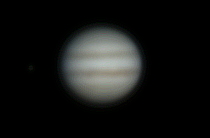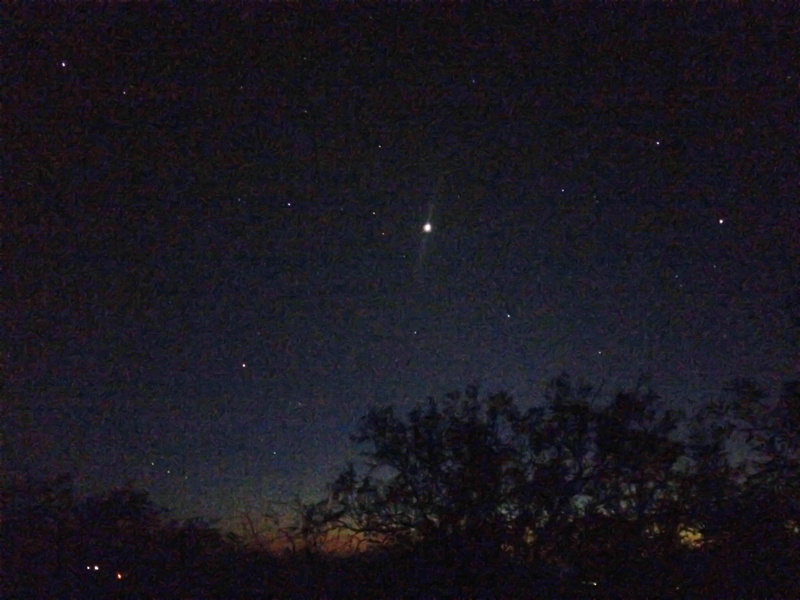D7200 DSLR Imaging: Venus, Mercury, Jupiter;
Night of Observing DSOs
Posted: 10 May 2015
The observatory was not opened Thursday, 30 April 2015. That evening I trained members of the Oracle Dark Skies Committee and Park rangers on how to set up and use the four telescopes that had been donated to Oracle State Park in recognition of it being named as an "International Dark Sky Park" by the International Dark-Sky Association. The sky was partly cloudy after sunset but the members got to practice locating the Moon and Venus. When I returned home the sky was mostly covered by thin clouds. Cloudy skies continued through the weekend. Had three brief thunderstorms early Monday morning, 4 May, with a short hail storm (pea-sized), and several rainshower episodes in the afternoon and evening, for a total rain amount of 0.56" for the day. The sky finally cleared on Thursday, 7 May, with forecasts of clear skies that night, getting my hopes up of being able to open the observatory that night after I attended a meeting of the Oracle Dark Skies Committee. However, clouds began appearing mid-day and a surprise rainshower developed in the late afternoon. The night remained cloudy. Friday, 8 May, dawned clear, with a clear night forecast, getting my hopes up again. But as has been typical for the past couple of years, clouds began forming mid-day, dashing my hopes once again. Grumble... Clouds continued Saturday, 9 May, but began clearing mid-day, once again getting my hopes up. As sunset approached the sky stayed clear!
|
Open: Saturday, 9 May 2015, 1821 MST Temperature: 78°F |
Session: 817 Conditions: Clear, some breezes |
1827 MST: synced observatory clock to WWV. Then tried to view Mercury through the 8" LX200-ACF, 83X. Not visible. Slewed to Venus to focus, 83X, then returned to Mercury. I could now view faint Mercury. Being in focus really helps! It appeared to be about 50% illuminated. Switched to 222X and could now see that it was slightly less than 50% illuminated. The sky was still bright about 30 minutes before sunset.
Returned to Venus, mounted the D7200 DSLR at prime focus + 2X PowerMate. Focused and locked it. Did some HD video recordings, 1.3X crop factor, 60 fps, at various shutter speeds and ISO values. This is a stack of 933 frames (15 seconds), 1/400sec, ISO 500:

Then slewed to Mercury and did more HD video recordings. This is a stack of 933 frames, 1/160sec, ISO 500, with lots of post-stacking editing due to poor seeing:

1907 MST: spotted Jupiter high in the sky with the naked eye with some difficulty. Venus was easy to see high up in the western sky. Mercury was not yet visible to the naked eye. 1909 MST: Mercury was now faintly visible in the 7x50 finderscope. 1915 MST: sunset. 1922 MST: Mercury was now too low for imaging; still not visible to the naked eye. 1933 MST: would catch occasional glimpses of Mercury with the naked eye; very difficult to see. 1937 MST: Mercury was slightly easier to see now but still difficult.
Slewed the telescope to the star Procyon and did a focus test using the Bahtinov Mask. Then slewed to Jupiter and did lots of HD video recordings at various exposure settings. This is a stack of 1239 frames (20 seconds), 1/60sec, ISO 800:

1958 MST: ended planet imaging. My plan for the remainder of the night was to do lots of observing, especially deep sky objects (DSOs). I hadn't done that in a long time. First viewed Jupiter and the four Galilean Moons, 222X. Seeing was not very good. 2008 MST: observed the moon Ganymede being eclipsed by Jupiter's shadow, 83X. Next viewed the double star Castor, 83X.
2021 MST, took this iPhone 5s handheld photo of the western sky using NightCap Pro (Light Boost, 1/2sec, ISO 4000):

Bright Venus is near the center, with the constellation of Auriga and its bright star Capella at the right, the star Procyon at the upper left, and setting Orion at the lower left.
2030 MST: began preparing for DSO observing. 2043 MST: end of Astronomical Twilight. Started with the AutoStar "Tonight's Best" Guided Tour using 83X: M13 (Hercules Globular Cluster), M44 (Praesepe open cluster), M37 (open cluster), M38 (open cluster), M36 (open cluster), M35 (open cluster), M92 (globular cluster), M82 (Cigar Galaxy), M5 (globular cluster), M104 (Sombrero Galaxy), M68 (globular cluster), Centaurus A (galaxy), and M51 (Whirlpool Galaxy).
Next I visited some galaxies in the constellation of Leo: NGC2903, M95, M96, NGC3377, M105, M65, NGC3626, M66, NGC3628 (part of the Leo Triplet with M65 and M66 in the field-of-view), and another triplet NGC3384 and NGC3389 with M105 in the FOV.
Visited many galaxies in Virgo: NGC4261, M61, M84, M86, M49, M87, M89, M90, M58, M104, M59, M60, and NGC4697. Also viewed the quasar 3C273. Viewed M104 (Sombrero Galaxy) using 222X.
2141 MST: viewed Omega Centauri (NGC5139, globular cluster), 83X. Although very low in the south, the view of this large globular cluster was very nice. Then visited NGC5248 (galaxy) in Boötes, followed by some galaxies in the constellation of Coma Berenices: M98, M99, M100, M85, M86, M91, and M53.
2158 MST: viewed Saturn, 83X. It was low in the southeast and seeing was bad. Cassini Division was visible along with some cloud bands. Using 222X could see the moons Iapetus, Tethys, Dione, Rhea, and Titan. 2211 MST: switched to 166X, which slightly improved the view.
2218 MST: slewed back to Omega Centauri and viewed the globular cluster using 166X. That was a very impressive view. Then viewed M13 (globular cluster), 166X; also impressive. Then viewed M57 (Ring Nebula), 166X. Lovely view at 166X.
Last object viewed this night was Epsilon Lyrae (Double Double Star), 166X and 83X. Low altitude and poor seeing made splitting the secondary components difficult.
2230 MST: began closing up for the night. It was a fun night of observing.
As I have mentioned a few times in these Cassiopeia Observatory reports, I enjoy spending time just observing with my telescopes. I skip the challenges (and fun) of astrophotography and enjoy viewing our Universe. I recently read a new book, well "new" to me since I had never taken the time to read it before, and the beginning of Chapter IV really hit me with its relevance:

Those "thousand superfluous wants of modern 'civilization' really intrude on our daily lives, making time spent just looking up so much more meaningful and relaxing. This great realization is found in the book "Astronomy for Amateurs" by Camille Flammarion, which was first published in 1904. Yes, 111 years ago! Something to think about when you head off to a night of observing.
|
Close: Saturday, 9 May 2015, 2247 MST Temperature: 50°F |
|
As I mentioned in a report on 9 April 2015, this year is the 10th anniversary of my initial visits to "Oracle Observatory" and that I would be linking to past reports as appropriate. Here is my report from 30 April 2005.
Comments are welcome using Email. If you are on Twitter you can use the button below to tweet this report to your followers. Thanks.
Cassiopeia Observatory Home Page
Copyright ©2015 Michael L. Weasner / mweasner@me.com
URL = http://www.weasner.com/co/Reports/2015/05/10/index.html
